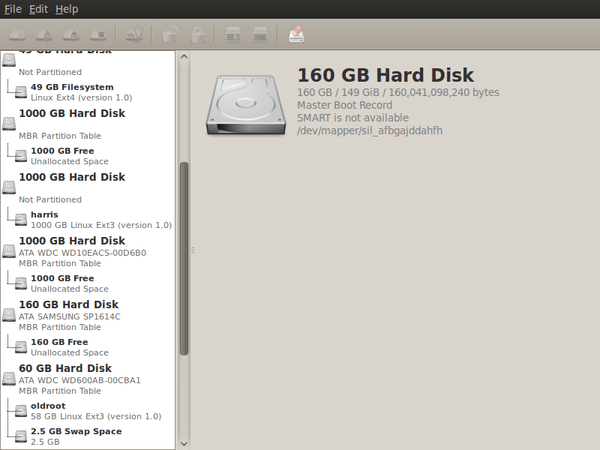TOPIC: PARALLEL ATA
Troubleshooting SATA drive detection issues in Ubuntu 9.10
4th November 2009One of the early signs that I noticed after upgrading my main PC to Ubuntu 9.10 was a warning regarding the health of one of my hard disks. While others have reported that this can be triggered by the least bit of roughness in a SMART profile, that's not how it was for me. The PATA disk that has hosted my Ubuntu installation since the move away from Windows had a few bad sectors but no adverse warning. It was a 320 GB Western Digital SATA drive that was raising alarm bells with its 200 bad sectors.
The conveyor of this news was Palimpsest (not sure how it got that name even when I read the Wikipedia entry) and that is part of the subject of this post. Some have been irritated by its disk health warnings, yet it's easy to make them go away by turning off Disk Notifications in the dialogue that going to System > Preferences > Startup Applications will bring up for you. To fire up Palimpsest itself, there's always the command line, but you'll find it at System > Administration > Disk Utility too.
My complaint about it is that I see the same hard drive listed in there more than once, and it takes some finding to separate the real entries from the "bogus" ones. Whether this is because Ubuntu has seen my SATA drives with SIL RAID mappings (for the record, I have no array set up) or not is an open question, but it's one that needs continued investigation and I already have had a go with the dmraid command.
Even GParted shows both the original /dev/sd* type addressing and the /dev/mapper/sil_* equivalent, with the latter being the one with which you need to work (Ubuntu now lives on a partition on one of the SATA drives, which is how I noticed this). All in all, it looks less than tidy, so additional interrogation is in order, especially when I have no recollection of 9.04 doing anything of the sort.

Hard drive cooling
5th March 2007Having had my main PC's case hot to the touch last summer, I was wondering what was causing it. Components like CPU's and graphics cards would need to generate a lot of heat to manage that. However, my main suspects are the hard drives in the machine: they do run hot after all and sit in a drive cradle connected directly to the case framework. As it happens, I was in Manchester's branch of PC World yesterday and spotted Akasa hard drive coolers in stock for just £7.99 each. These dual fan units screw onto the base of your hard drive and their power connector can couple between a PATA power socket and a PSU power cable so that they can draw the power that they need without adding clutter. I bought two of the things and installed them; I'll now see how they get on.